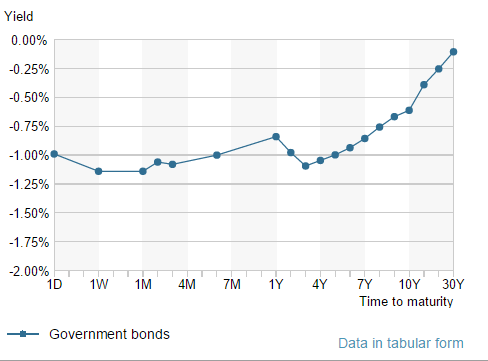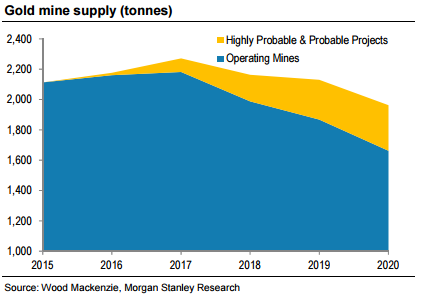Gold is probably the least understood and most confusing investment asset out there. There are so many misconceptions that get repeated over and over again and then become common knowledge even though they are flat wrong; “gold does well in inflationary environments”, “gold performs poorly when inflation is falling” “gold is a hedge against a market crash”, “gold is a safe haven” and I could go on and on.
My purpose in writing this post is to remove some of the mystery from gold as an investment asset and add some clarity as to why an investor might want to own gold. Gold priced in US dollars has risen by more than 30% thus far in 2016 and the reasons for this rapid ascent after more than four years of a brutal bear market are revealing and help us to understand gold as an investment in 2016.
A couple of weeks ago a friend of mine asked me “why would someone own gold? Why is it worth so much?”. These are natural questions and the answers are important. The answers are that people might own gold for very different reasons and the reason that it is worth US1365/ounce at last check is that there are many people who are eager and willing to pay that much for gold. However, to offer a slightly more nuanced answer to the question of “why own gold?” is that gold is truth, gold doesn’t lie, gold doesn’t fake numbers on a balance sheet or income statement, gold can’t go into trillions of dollars of debt, gold can’t devalue itself, etc. You get the picture. Gold is simple, tangible, and widely recognized as a store of value by billions of people for thousands of years.
Gold’s value, like any other asset, can be best understood by evaluating the opportunity cost of owning gold relative to other alternatives. Given that gold is best characterized as a currency, a store of value, and an asset that can be used to exchange value across the world the best way to evaluate gold is to compare it to holding paper currencies. Essentially the question comes down to how well does my purchasing power hold up over time if I choose to invest in a certain amount of gold relative to if I chose to hold the same value in paper currencies.
Right now holding US dollars either in cash or in a bank account doesn’t make much of a difference because short term deposits essentially yield close to zero. Whereas investing cash in longer term bonds such as the U.S. 10-year Treasury Note isn’t much more attractive especially when considering that the yield on the 10-year (1.36%) is less than inflation (U.S. CPI is 2.2%) and the interest is taxable (essentially resulting in a guarantee that holding a 10-year Treasury Note to maturity will result in a reduction in purchasing power).
The situation is even worse for holders of Swiss francs and Japanese yen due to the fact that the central banks of both countries have ensured that depositors receive negative interest for their deposits. Moreover, the sovereign bonds of both Switzerland and Japan offer negative yields far out in the maturity structure:
Swiss Government Bond Yield Curve
The yield on the Swiss 30-year is negative!
While the reasons why there has been such a drastic shift lower in interest rates globally are somewhat controversial and frankly multi-faceted, the facts are the facts. Cash sucks right now and investors are being “forced” to seek yield in increasingly risky places. While gold won’t yield you interest or dividend payments, it also won’t lie to you, it won’t vote to leave the EU, it won’t file false accounting reports, and it won’t miss earnings.
Perhaps most importantly the opportunity cost of holding gold as an investment have dropped significantly. In fact, for Swiss and Japanese investors it actually costs money to hold their country’s fiat currency instead of gold!
The reasons for holding gold are simple:
- A store of value that will maintain purchasing power over time.
- An alternative asset that often experiences increased investment demand during periods of economic stress and financial market turmoil.
- Gold is a global currency that is becoming an increasingly attractive currency alternative as major currencies suddenly yield nothing or in some cases, less than nothing.
- As central banks continue to ‘crowd out’ investors from other asset classes (equities, fixed income, etc.) gold is a natural beneficiary as the money has to go somewhere and it generally finds its way to where it is treated best (higher prices lead to higher prices as bull markets benefit from a positive feedback loop).
One final kicker which adds to a bullish outlook for gold is the fact that new mine supply is either entering, or has already entered, into a terminal decline:
While I don’t view the negative rate of growth of new mine supply as a major factor in the case for gold, the fact that gold simply isn’t easy to come by and is increasingly costly to extract from the earth is certainly a supportive factor especially during periods of corrections in the gold price.
In summary, during the first half of 2016 we have literally seen a complete 180 degree turn in terms of the macro backdrop and outlook for gold; we began the year facing a Fed rate hike cycle (essentially raising the opportunity cost for holding gold) only to see the Fed quickly backtrack and a Fed rate cut appears just as likely as a rate hike i.e. not likely at all. Moreover, the outlook for growth in developed economies such as Japan, the UK, and the euro area couldn’t be much more bleak. This has caused interest rates to fall even farther across much of the globe, thereby increasing gold’s relative attractiveness as a currency/investment alternative.
DISCLAIMER: The work included in this article is based on technical charts, current events, the author’s opinions, and corporate press releases. It may contain errors, and you shouldn’t make any investment decision based solely on what you read here. This publication contains forward-looking statements, including but not limited to comments regarding predictions and projections. Forward-looking statements address future events and conditions and therefore involve inherent risks and uncertainties. Actual results may differ materially from those currently anticipated in such statements. The views expressed in this publication and on the EnergyandGold website do not necessarily reflect the views of Energy and Gold Publishing LTD, publisher of EnergyandGold.com. This publication is provided for informational and entertainment purposes only and is not a recommendation to buy or sell any security. Always thoroughly do your own due diligence and talk to a licensed investment adviser prior to making any investment decisions. Junior resource companies can easily lose 100% of their value so read company profiles on www.SEDAR.com for important risk disclosures. It’s your money and your responsibility.


